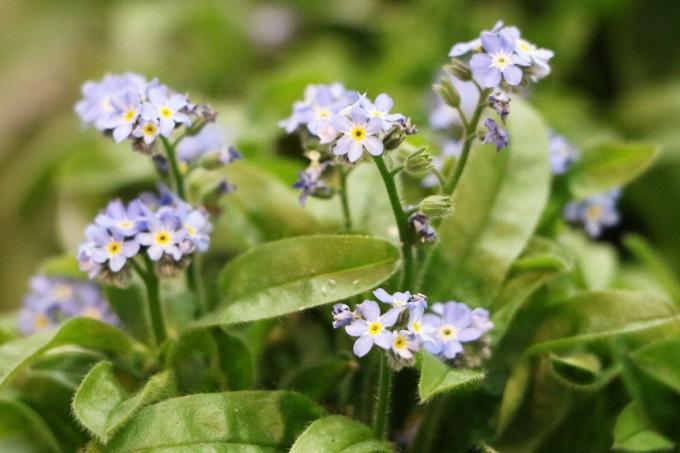
table of contents
- Characteristics
- Location
- floor
- plants
- Plant neighbors
- care
- to water
- Fertilize
- Cut
- Overwinter
- Multiply
- Diseases and pests
Profile and care information open +conclude -
- Flower color
- pink, purple, white, blue, light blue
- Location
- Partial shade, sunny
- Heyday
- April, May, June, July
- Growth habit
- upright, bushy
- height
- up to 45 cm high
- Soil type
- sandy, loamy, gritty, clayey
- Soil moisture
- moderately moist, fresh
- PH value
- neutral
- Limescale tolerance
- Calcium tolerant
- humus
- rich in humus
- Poisonous
- no
- Plant families
- Predator Family, Boraginaceae
- Plant species
- Bedding plants, potted plants
- Garden style
- Flower garden, wild garden
The forest forget-me-not conjures up sky-blue flower carpets in the garden from late spring. In the pot or balcony box, the many small flowers are also a real eye-catcher. The name "forget-me-not", around which many myths are entwined, goes back to the 15th Century back. It is unclear whether the flowers were given by the man to the woman as a token of love and loyalty, or whether the woman was supposed to remind her of her lover.
Characteristics
- botanical name: Myosotis sylvatica
- Synonyms: Forest forget-me-nots (alternative spelling), mouse-eared
- Height: 15 to 45 centimeters
- Spread: 15 to 20 centimeters
- Flowering period: April / May to July
- Flower: several flowers in an upright pseudo-panicle
- Flower color: initially reddish purple, later sky blue
- Leaf: green, lanceolate, entire
- Insect pasture
Location
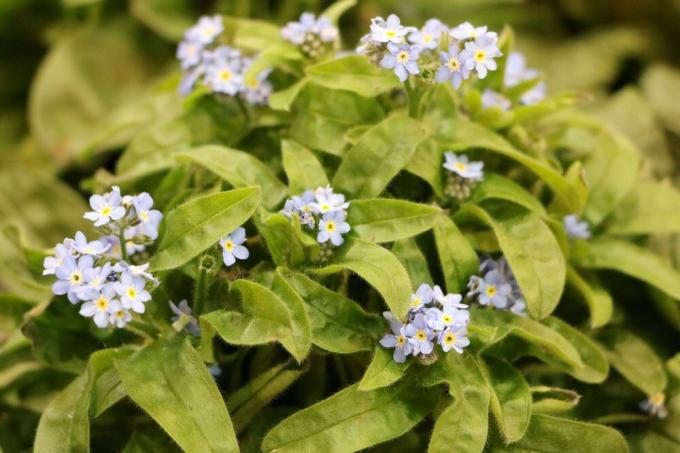
In the great outdoors, the forest forget-me-not prefers greasy meadows, fringes, tall herbaceous corridors, cattle storage areas or woodlands as locations. The ornamental forms of Myosotis sylvatica are mainly used in the garden. The location should be sunny to partially shaded.
floor
Forget-me-nots love soils that
- sandy to loamy
- fresh to moderately moist
- permeable
- nutritious
- rich in humus
are. Myosotis sylvatica is tolerant of lime. The plants even prefer soils that are rather calcareous. On the other hand, they do not like heavy and waterlogged soils at all.
In the bucket culture, the forest forget-me-not prefers a substrate with the following properties:
- gritty-loamy
- sandy-clay or
- loamy-clayey
But it is also satisfied with normal potted plant soil.
plants
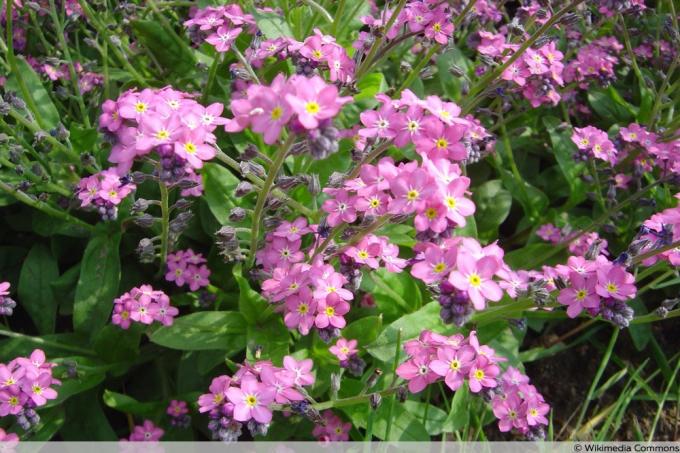
Source: David Monniaux, Myosotis sylvatica Rosylva dsc00966, Edited by Gartenlexikon.de (MKr), CC BY-SA 3.0
Forget-me-nots are offered as pre-grown potted plants from spring to autumn. Basically you can plant Myosotis sylvatica in the garden at any time during this period, provided the period of heavy frosts is over. However, the best date for planting out is between mid-June and September. The planting distance should be about 20 centimeters.
Buy preferred potted plants
Although forest forget-me-nots naturally have sky-blue flowers, other shades of blue or plants with white or pink flowers are also available on the market. In so-called Duo or trio pots are forest forget-me-nots in different (two or three) flower colors.
Plants in the tub culture
Since forest forget-me-nots need a lot of space for optimal development, you should not choose the planter too small. In addition, the plants look particularly pretty in small groups of three to five specimens. For planting
- in the bucket, follow the instructions below:
- Lay a drainage layer of gravel and / or potsherds on the bottom of the pot
- Cover the drainage layer with a thin substrate layer
- Place plants at a distance of 15 to 20 centimeters in the planter
- Planting depth: do not set deeper than in the top before
- Fill the planter with substrate
- press on
- pour on
Tip: To avoid waterlogging, you should only use planters that have at least one drainage hole.
Plant neighbors
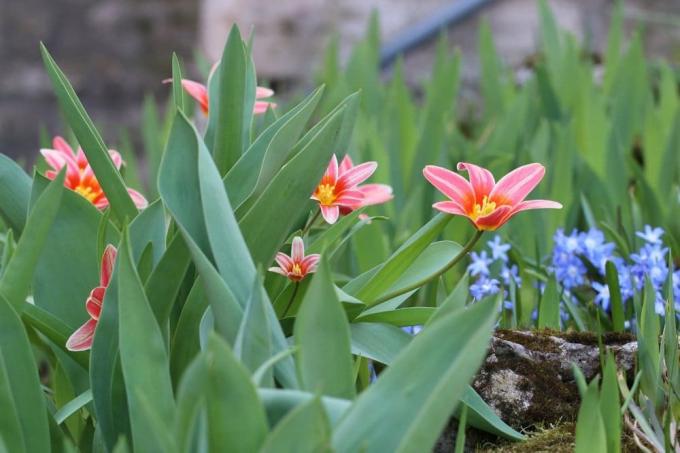
Forest forget-me-nots fit well in the garden
- Flower beds
- Bezels
- Discounts
But they can also be used for grave planting or cultivated in pots on balconies and patios. Forest forget-me-nots come into their own when they are planted in a group. The plants are not suitable as solitaires. The distance to neighboring plants should be about 30 centimeters so that they are not suppressed.
Forget-me-nots belong to the spring bloomers. Therefore, they fit well in spring beds. Ideal neighbors are plants that bloom at the same time, such as:
- daisy
- Horned violets
- Daffodils
- Primroses
- Tulips
Tip: Since forest forget-me-nots have very small flowers, tulips are particularly effective.
Other plant neighbors of Myosotis sylvatica are Gauklerbrich, Goldfelbrich or Marsh marigolds. Since forget-me-nots are supposed to ward off the raspberry beetles, they are suitable as underplanting for raspberry bushes. Forest forget-me-nots are often used to fill the gaps in borders, as most of them do Perennials drive out later. In the bed, the plants are ideal for framing.
care
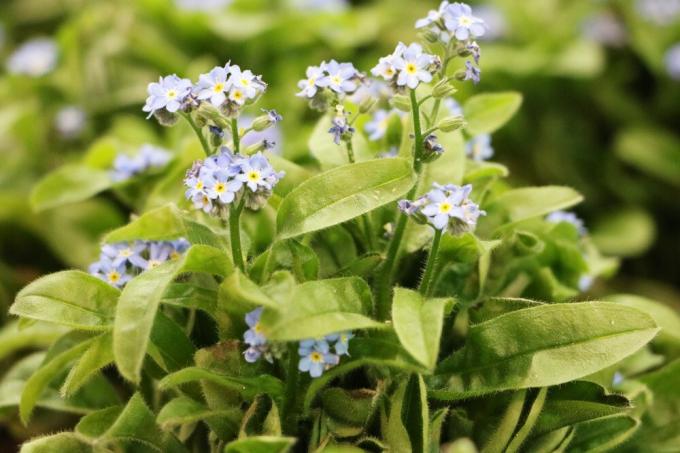
One thing in advance: You do not need to study care instructions for the optimal development of the plants. Once they have been planted in the garden, they actually don't need any further care. You only need water in dry periods. If they are cultivated in a tub, however, you should provide the plants with regular watering.
Although forest forget-me-nots are undemanding in maintenance, they have a small disadvantage. By self-sowing, you will soon find them outside of the desired location, for example on gravel paths or in Vegetable garden. But seedlings also appear at the desired location. Since forest forget-me-nots need a lot of space, you should remove the excess seedlings in spring and autumn.
to water
If the forest forget-me-nots are planted in the garden, then the rain is usually enough for them to give water. However, if there is no rain, the plants need additional watering. In the container culture you should water the plants regularly, especially if they are under a roof overhang where no rain can get. However, you don't have to keep the plants moist all the time. On the contrary, the ideal care is to let the substrate dry off between waterings.
Regardless of the cultivation, the best time to water is in the morning or in the evening, when the plants have not yet been no longer stand in the sun. You should also try to ensure that as little irrigation water as possible hits the leaves and flowers. In addition, forest forget-me-nots prefer a slow watering process. The plants do not like a surge of water and they do not tolerate waterlogging either.
Fertilize
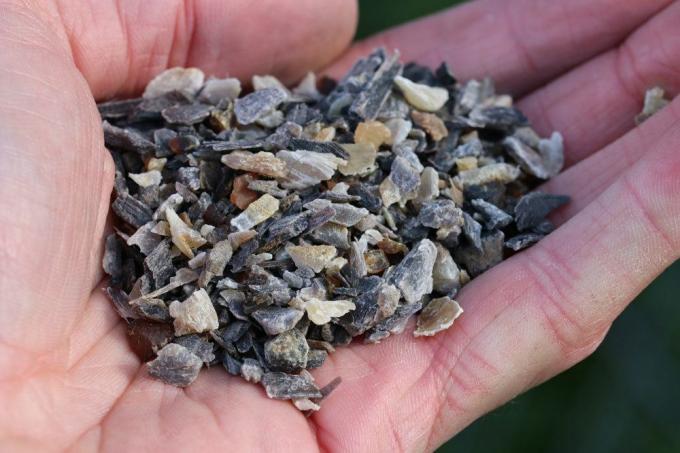
Organic fertilizers such as horn shavings are particularly suitable for Myosotis sylvatica. You should not use conventional nitrogenous fertilizers for maintenance, as too much nitrogen damages the plants and increases the risk of fungal diseases.
Note: You should be restrained when fertilizing, because it is sometimes even recommended not to fertilize the plants at all.
Cut
Forget-me-nots don't need to be cut. In order to stimulate the formation of new buds, you should remove wilted flowers (panicles) from time to time. This also has the advantage of curbing self-seeding of myositis sylvatica.
In order to accelerate the flowering in the coming year, you should try towards the end of autumn or At the beginning of winter, remove all dried up and withered parts of the plant. Do you want to avoid or then you should cut back the plants earlier.
Overwinter
Planted out in the garden, the plants usually do not need winter protection as they can withstand temperatures down to minus 29 degrees. However, if your garden is in a region that can get very cold, the plants will be happy to have protection made of brushwood, straw, leaves or a fleece.
In the tub culture, Myosotis sylvatica always needs winter protection, as cold and frost quickly penetrate the planter. Ideally, the plants are packed from all sides according to the following instructions:
- Cover the walls of the planter with a special plant protection agent
- Against the cold "from below": place the pot on a thick wooden board or a styrofoam plate
- place in a protected location (rain, snow, wind)
- ideally place in front of a (heated) house wall (gives off heat)
Tip: Since Myosotis sylvatica needs watering in the bucket culture as part of winter care, you should remember when packing that you have to water the plant.
Multiply
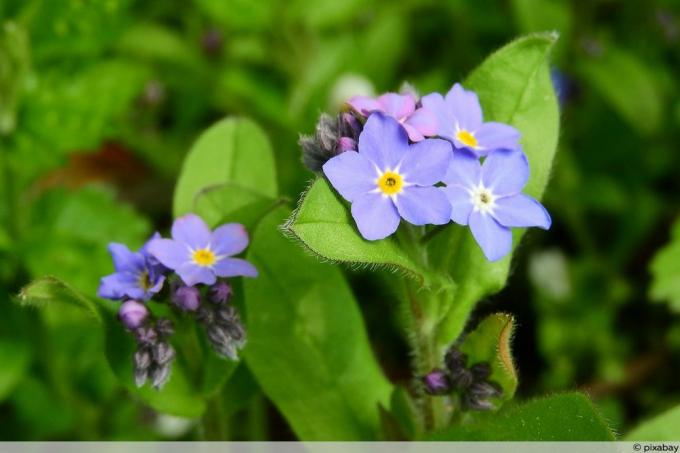
Self-sowing
Since Myosotis sylvatica sows itself, the plants take care of their own reproduction. However, this is uncontrolled.
Seeds
The targeted and controlled reproduction of the plants takes place with seeds that you can get in stores. The ideal time for sowing is between the end of May and the end of July. The flowering will then take place in the coming year. You can either sprinkle the seeds directly into the bed or prefer young plants in pots.
Instructions for sowing directly into the bed
- Sprinkle seeds on the ground at the intended location
- Cover seeds only thinly with soil (light germinator)
- carefully pour on or spray
- Do not let the soil dry out
- isolated from the end of August
- Plant spacing: 15 to 20 centimeters
Instructions for growing young plants
- Prepare the seed pots with loamy potting soil
- Sow seeds
- Cover the seeds with a very thin layer of soil (light germinator)
- spray with water (watering would wash away the seeds)
- place in a bright location without direct sunlight
- ideal temperature until germination: 18 degrees Celsius
- Germination time: two to three weeks
- Keep the substrate moist until germination
- Separate seedlings (distance: about 10 centimeters)
- Transplant young plants in September
- Protect offspring with a fleece in frosty conditions
share
The division of the plants is another way of multiplying the forest forget-me-nots. For this purpose, individual plants are dug up and divided. When sharing, it is important that both parts have enough roots so that they can survive. In addition, the plants must be put back into the ground immediately after they have been divided.
Diseases and pests
Powdery mildew, downy mildew or gray mold can attack the plants in very damp weather or due to incorrect care. If you have discovered an infestation, the infected parts of the plant must be removed immediately and preferably generously. This not only serves to protect the forest forget-me-nots, but also to protect neighboring plants, because the molds spread quickly.
Aphids and spider mites are extremely rare in the forest forget-me-nots. Although this can Pests can be controlled with home and organic remedies, but for spider mites, serious consideration should be given to removing the infested plant (s).



